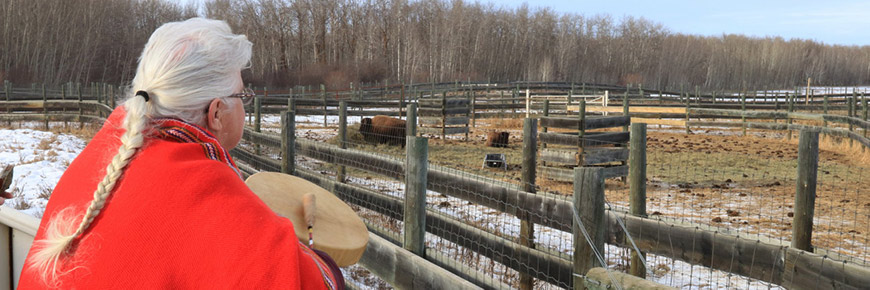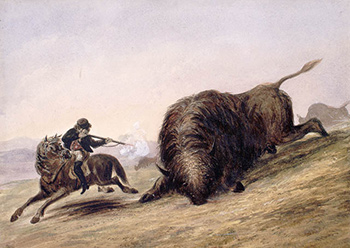
Indigenous connections
Elk Island National Park
Many Parks Canada’s places have seen a transition over time from a past where Indigenous peoples were separated from their traditional lands and waters. Today, Parks Canada is committed to ensuring Indigenous connections are honoured, and Indigenous rights are respected. Parks Canada provides a system of national heritage places that recognize and honour the contributions of Indigenous peoples, their histories and cultures, as well as the special relationships Indigenous peoples have with traditional lands and waters.
Elk Island National Park has an extensive cultural history dating back to the receding of the glaciers. Evidence of human activity in the Amiskwaciy (Beaver Hills) area dates back as far as 8,000 years ago. Hundreds of Indigenous archaeological sites dot the landscape throughout Elk Island National Park, most of which were campsites and stone tool-making sites
Bison and people
By the mid 1800s, the Plains Cree had settled into familiar hunting patterns on the Canadian prairies. When hunting bison, the Plains Cree travelled and worked together in large bands and used a number of different hunting methods - hunting on horseback and using buffalo pounds (circular enclosures). All of the large ungulates were hunted but the bison was the most sought after. The bison provided a year-round source of food; skins provided materials for shelters, clothing and storage bags; and even the horns and bones were used.
Hunting bison before the use of horses and firearms was no easy task. The main weapons First Nations people had were knowledge and courage. The profound knowledge of bison behaviour gained over thousands of years of close contact with bison herds allowed Indigenous peoples to be very successful at hunting these large mammals.
The balance between people and animals shifted in the mid-to-late nineteenth century as bison were commercially hunted in large numbers. The once thundering herds were devastated and, as a result, food shortages broke out amongst the Indigenous peoples.

By 1890, the commercial demand for bison products had reduced the herds from 30 million to less than 1,000 animals.
As their way of life, and very survival, was under threat, the people negotiated treaties with the Crown to protect their lands, including Treaty Six.
The rich supply of plants and other game in the Amiskwaciy area – roots, berries, deer, moose, elk and even fish - provided the local Indigenous peoples with a varied and nutritious diet. With the depletion of the game and fur species, the Indigenous peoples left the area.
Current connections

Elk Island National Park frequently relocates bison to conservation projects and in the past decade has offered bison to Indigenous communities as well. Parks Canada is honored to play an active role in reconciliation by providing bison to facilitate cultural or socio-economic opportunities related to bison in an effort to bring the culturally significant animal back to their traditional rangeland.
Past Indigenous translocations include 87 plains bison calves to the Blackfeet nation in Montana in 2016 through the buffalo treaty, 25 wood bison to Saulteaux First Nation near North Battleford, Saskatchewan in 2018 and 31 plains bison to Flying Dust First Nation in Saskatchewan in 2019. Individual surplus bison have also been donated to Treaty Six First Nations in Alberta and Indigenous organizations near the Park for cultural purposes or to contribute to Indigenous community food banks.
The park also shares Indigenous culture through Indigenous programming, Indigenous performances at special events and Indigenous art and wares for purchase at the Wahkotowin Visitor Information Centre. Parks Canada also regularly consults with Indigenous groups before making key management decisions.
Star Blanket

Elk Island National Park worked closely with Indigenous communities and Correctional Service Canada (CSC) in the development of the Wahkotowin Visitor Information Centre exhibits. Women from the Edmonton Institution for Women handcrafted a traditional bison-hide Star Blanket to showcase Indigenous heritage. The prominent exhibit greets visitors when they first enter the new Wahkotowin Visitor Information Centre. By working with CSC, federally-sentenced Indigenous women gain employable skills and training that will prepare them for success when they are released. The gift shop also features local Indigenous crafts and wares that support Indigenous businesses.
The Star Blanket lies deep within stories and spirituality. It represents life and is the blueprint to many ceremonies. Indigenous people use Star Blankets to honour individuals at the time of life changing events such as births, graduations, vision quests, and marriages. It is used to honour those who have passed and to accompany them back home to the Spirit World. To give a Star Blanket is to show utmost respect, honour and admiration.
Related links
- Date modified :